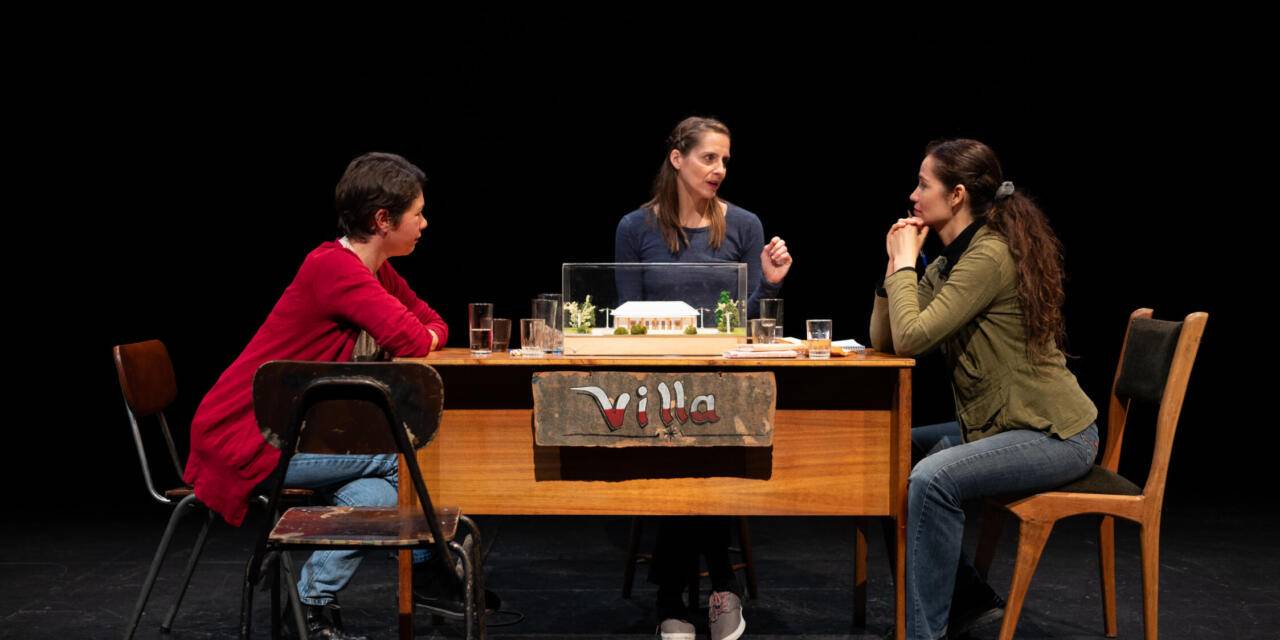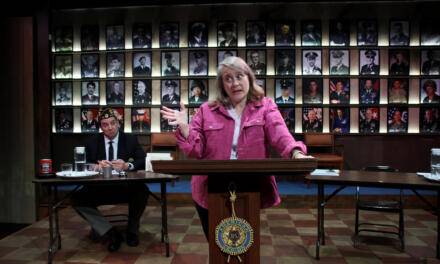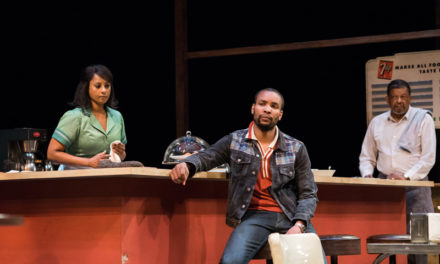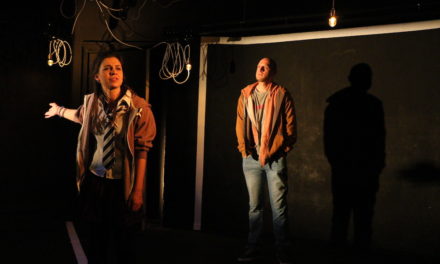Catching up with Guillermo Calderón’s Villa at Santiago a Mil after almost 12 years has been a treat. This is not because it presents easy or pleasurable subject matter but rather because it feels as pertinent and important as it did when I first saw it in July 2012. Presented then at Chile’s Memory and Human Rights Museum, it was performed with Discurso, a farewell discourse from Chile’s first woman president, Michelle Bachelet on stepping down in 2010. I remember thinking Villa provided an astute and timely dissection of the politics of commemoration directed by the author with clinical precision.
Twelve years on, at the Mori Recoleta theatre, Villa is back with the same cast – now older, still wearing their trauma, perhaps now mothers themselves. Calderón lets the text speak for itself with the audience bringing their own lived experience to their reading of the production. The three actresses wear the passing of time on their faces and in their posture. There’s a weariness perhaps to the three performers, Francisca Lewin, Carla Romero and Macarena Zamudio. They are no longer the fresh-faced women who first performed the roles.
The play opens with three women in a room; at the centre a table with a model of a building and a sign hanging from the front of the table that simply says “Villa”. María Fernanda Videla’s set is simple and effective: a few scattered chairs, a trolley filled with empty glasses and water. The empty chairs and glasses point to absence: gaps are there from the outset.
The three women, all called Alejandra, have been tasked with recommending what happens to the Villa Grimaldi, a notorious site of torture, imprisonment, and death during the Pinochet regime where 4,500 people were held and tortured and 226 people suffered enforced disappearance and murder between 1973 and 1979. The three Alejandras don’t appear to know each other. One appears to be part of a committee to determine what happens to the now abandoned Villa Grimaldi but when this committee can’t agree — with one board member throwing an ashtray at another — the three Alejandras are invited to form a “special commission” and given the task of recommending the next steps.
There is a budget of twenty-six million euros at stake here to fund the “renovation” of the now abandoned and derelict building, but the three women find agreement as tricky as the board members who passed the responsibility over to them. One Alejandra, played by Carla Romero, defends the idea of rebuilding it as was with every flaw and crack recreated, “every irrelevant detail … a sort of realist Disneyland reality” where those who visit are made to “feel” like prisoners. This immersive museum would have survivors as guides and would offer “authenticity” to any and all visitors. But what, the play asks, is authentic? And what are the ethics of what’s proposed? Carla Romero’s Alejandra is animated and speaks purposely and intensely to conjure the evangelical potential of Villa as a house of horrors for all those who willingly now step in to experience some diluted version of what really went on inside.
Francisca Lewin’s Alejandra defends the idea of a super museum, a white sanitised space filled with photographs, testimonials and an array of apple mac computers where any number of clicks can provide endless possibilities for discovering the past: history at your fingertips. Stories and facts, details of what was where and what happened to all those held there available on demand for all visitors. Her tone is as clipped and defined as the clicks she evokes – as clean as the pristine, hospital-like museum she envisages.
The ethics of each option are meticulously scrutinised by the trio. Macarena Zamudio’s Alejandra argues for the impossibility of putting those who visit in the position of those who were held there and for “artistic art” having potential to make sense of what happened there. Carla Romero’s Alejandra posits some midway between a house of horrors and a museum – she cannot envisage any kind of option with a happy ending where “beauty triumphed, the human spirit triumphed, peace triumphed” when the evidence is that women were raped, abused and killed here. For Francisca Lewin’s Alejandra, the more it looks the original, the more fake it will be. She argues for something that is drastically different, a pink and obelisk with a neon sign saying “Villa” at the top. Macarena Zamudio’s Alejandra posits leaving it as is, a graveyard.
The three Alejandras are not at ease with each other, tempers flaring at certain moments with Macarena Zamudio’s Alejandra — the representative from the Villa committee — trying to keep the peace. The conversation is tetchy and uneasy because there is a great deal at stake. Humour is present: a dark, absurdist humour rooted in word play and incongruities. The women work through numerous configurations in addition to the museum and house of horrors: a bronze plaque, an archive, a park with a cinnamon tree. All are presented in forensic detail. They settle, finally, on an empty park where people can come and imagine (or not), remember (or not), run or play or just be. A space that can allow for and indeed accommodate infinite memories and possibilities.
The three women realise that they have been given the terrible responsibility of deciding because they were born in Villa Grimaldi; their mothers political prisoners raped by guards. Once the three grasp the horrific history they share, they speak of what this means: Francisca Lewin’s Alejandra refers to having been “raped indirectly” – the crime as invisible as her Mapuche roots. Her mother is Mapuche but she has inherited her father’s colouring. Appearances, the piece suggests, can be deceptive. Macarena Zamudio’s Alejandra speaks of her mother not wanting to kiss her because she looks so like the intelligence officer who raped her. She has even considered plastic surgery to address this trauma.
“We all react differently” says Macarena Zamudio’s Alejandra and this need to understand and respect difference is in many ways the core of the piece. Motives are difficult to read; behaviour not always easy to understand. Villa refuses to legitimise one viewpoint over others. Trauma manifests itself in different ways; it is addressed in different ways. By asking how the wishes of those directly affected are accommodated, the piece posits timely questions about who makes decisions on commemoration. It questions the role of art in this process and interrogates claims that redemption is possible through art.
Calderón’s precise, nuanced direction captures the evolving dynamics between the three Alejandras. The women sit around the table, they stand, they leave to go to the bathroom. There is a restless energy in the room. Nothing stands still. The Alejandras embody the difficult dialectics of a nation coming to terms with its history, asking complex questions about its past. The outstanding cast makes the trio feel like living entities with weighty difficult histories that they are each, still, trying to come to terms with. Exposition is refreshingly scarce. Revelations come without ever providing closure. At times it is as if we are watching the action reflected through the empty glasses on the trolley — a mirror of sorts where reality is always distorted.
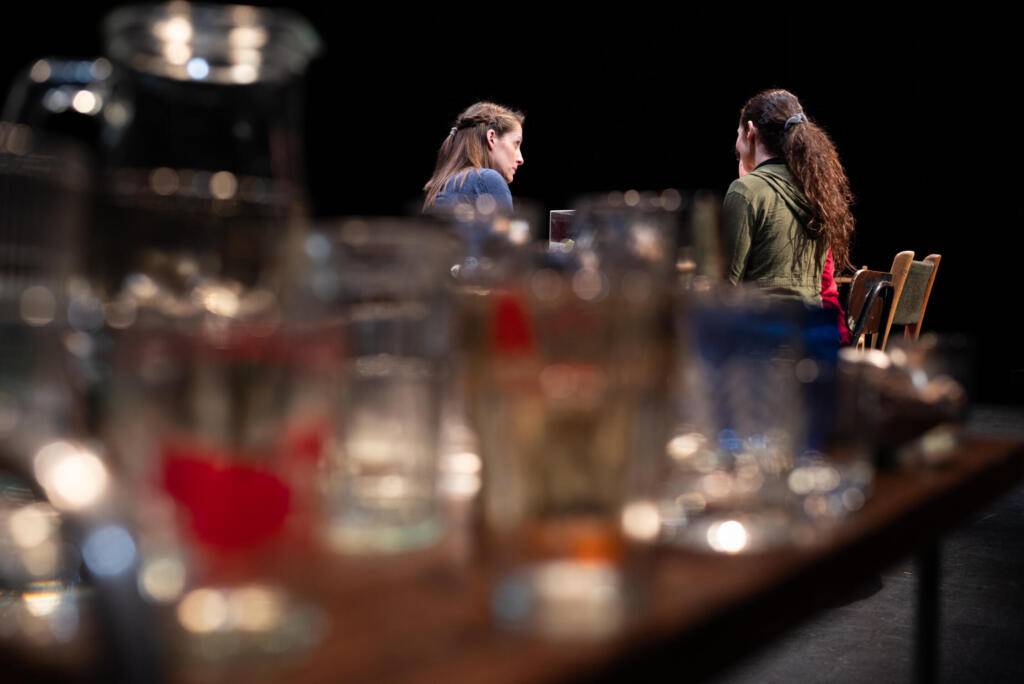
Action captured as if through a looking glass in Villa: Photo María Paz González
At the piece’s end, the three actresses stand behind the table and look directly at the audience. The model of the proposed museum lights up in red, as if on fire, the stage shudders and the women stand together, readying themselves for what is to come. Following the shudder, Dan Fogelberg’s “Leader of the Band” plays to close the piece: its lyrics speaking of “a living legacy” that these women embody.
It is Calderón and his creative team’s ability to give form to this legacy that makes Villa such a memorable experience. This is one of the most remarkable of twenty-first century plays, capturing the fault lines that continue to haunt this nation’s psyche. In this compelling production, the writing is animated, the dynamics between past and present played out with candour. Villa gives form to the tensions between the knowable and the unknowable that are always such a feature of history.
Villa played at Teatro Mori Recoleta as part of Santiago a Mil from 19 to 21 January 2024 and is now touring.
This post was written by the author in their personal capacity.The opinions expressed in this article are the author’s own and do not reflect the view of The Theatre Times, their staff or collaborators.
This post was written by Maria Delgado.
The views expressed here belong to the author and do not necessarily reflect our views and opinions.

